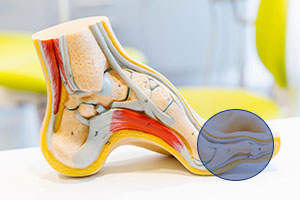
Cheilectomy Surgery
Hallux rigidus is an osteoarthritis condition affecting the joint in the big toe. This condition is prone to causing bone spurs that lead to stiffness, pain and difficulty with mobility in the big toe. In order to remove the bone and restore flexibility, Dr Alexander performs cheilectomy surgery.
What is cheilectomy surgery?
Cheilectomy is a surgical procedure used to treat hallux rigidus and other conditions impacting the big toe. The procedure involves removing bone spurs from the metatarsophalangeal (MTP) joint in the big toe, thereby relieving orthopaedic pain and improving functionality.
Not all cases of hallux rigidus require surgical intervention, but it is a condition that can cause a painful lump which restricts your ability to walk and wear shoes. Dr Alexander will thoroughly examine your condition and perform X-rays before determining if cheilectomy surgery is necessary.
When is cheilectomy surgery necessary?
The main reason for cheilectomy surgery is a severe case of hallux rigidus that has not responded to non-invasive treatments. However, other cases where Dr Alexander may perform cheilectomy surgery include:
- Arthritis: This is a painful and often debilitating condition affecting bone health. The feet can be affected by osteoarthritis, rheumatoid arthritis and post-traumatic arthritis that cause swelling of the joints.
- Lump: Bone spurs can lead to painful lumps on the joints, making walking and wearing shoes difficult.
What is the difference between a cheilectomy and bunion surgery?
While both procedures remove bone spurs on the foot, they specialise in different locations. Cheilectomy deals with the top of the MTP joint, while bunion surgery removes the outer spurs. Dr Alexander will first examine your foot and diagnose the issue before recommending treatment.
How is cheilectomy surgery performed?
Cheilectomy is a quick outpatient procedure Dr Alexander performs in his doctor's suites. First, you will be placed under general anaesthesia or receive local anaesthesia just for your foot. Then, Dr Alexander will make a small incision over the top of the big toe and remove the spurs from the bone. Once complete, he will stitch the wound and bandage the area.
You will be able to go home after the procedure but will require a lift as you won't be able to place weight on your foot.
Recovery after cheilectomy surgery
Dr Alexander will provide the proper prescriptions and techniques to help your recovery. It's essential to avoid placing weight on your foot for several weeks until you can wear regular shoes and walk.
Other steps to take during your recovery include:
- Finishing your prescribed medication courses
- Having regular check-in appointments with your doctor and physical therapist
- Keep your foot elevated
- Practice mobility exercises at home
Contact Us
GIVE US A CALL:
CHAT ON WHATSAPP:
MAIL US:
LIFE GROENKLOOF HOSPITAL:
Room 104, Medical Centre West, 50 George Storrar Drive, Groenkloof
RASLOUW PRIVATE HOSPITAL:
Suite 105, Cnr R55 and Lochner avenue, Raslouw, Centurion

